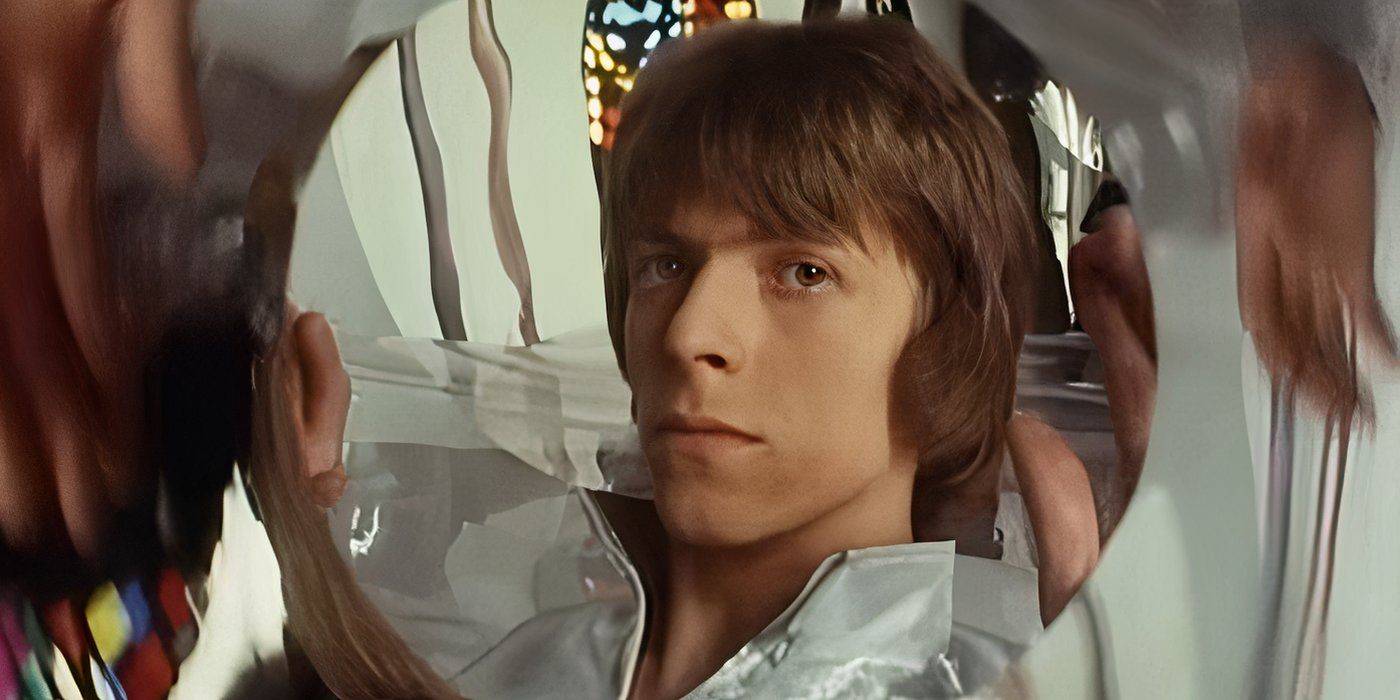David Bowie was one in all our age’s most celebrated musicians. With hit after electro-art-pop hit, the Skinny White Duke has been the king of pop-imagination, working with everybody from Elton John to Brian Eno (although not Conny Plank). He produced a catalog of genre-defining, western-world-shattering, cinematic pop masterpieces, whereas additionally sustaining an out of this universe persona.
Bowie’s profession is embellished with hit singles, and culturally curious, chart-topping albums, with sufficient celeb intrigue to advantage him popular culture sainthood. Inside that dense galaxy of success are singular stars which information us by David Bowie’s huge expertise. Here’s a checklist of the prime 10 songs that formed David Bowie’s profession. This checklist is greater than only a assortment of Bowie’s industrial successes, however an opportunity to focus on the bold releases that made David Bowie a legend to listeners and fellow musicians alike.
10
Area Oddity
Album: David Bowie (1969)
“Space Oddity” is a key song in the David Bowie lifecycle. First off, it’s Bowie’s first hit. Launched in 1969, the chart-topping debut glimpse into Bowie’s by no means ending potential is the results of a stable imaginative and prescient and unquenchable drive to succeed. In line with uDiscoverMusic, “Area Oddity” was written for one in all Bowie’s authentic initiatives, Feathers, a duo together with his early collaborator, John “Hutch” Hutchinson.
Initially composed as a name and response duet between “Floor Management” and “Main Tom,” “Area Oddity” is a mind-blowing instance of psychedelic rock and roll combined with masterful storytelling and cosmic ambition. Demos of “Area Oddity” would get Bowie into the identical room as Elton John’s producer, Gus Dudgeon, who would produce the ultimate album model of the tune. In line with MusicRadar, in 1975, the Decca Information producer mentioned “Area Oddity was so clearly the very best factor Bowie had written.” The world would agree.
9
Life On Mars?
Album: Hunky Dory (1971)
David Bowie was creating highly effective music even in his adolescent catalog. Bowie’s fourth album, Hunky Dory, comes from his early 70s output which is embellished with on-point glam-rock and art-pop rock and roll. Hunky Dory’s flagship can be the long-lasting “Life on Mars?” David Bowie’s career-spanning mega-hit would reignite his following in direction of the tip of his illustrious profession.
Associated
David Bowie’s 10 Best Music Videos (Ranked By YouTube Views)
The newly launched Moonage Daydream paid homage to Bowie’s iconic type introduced in his music movies, ranked right here by YouTube views.
In line with American Songwriter, the observe itself was written as a parody of Frank Sinatra’s “My Manner.” Apparently, Bowie had written lyrics to the French tune, “Comme d’habitude,” however was unable to position the challenge with any studio. Concurrently, Paul Anka was doing the identical work, which might find yourself being Sinatra’s iconic “My Manner.” Looking back, each songs are huge hits and helped arrange every singer with their very own slice of legacy. As followers, we will take pleasure in yet one more occasion of Bowie’s humorousness and ambition.
8
Younger People
Album: Younger People (1975)
“Younger People” is without doubt one of the most profitable examples of David Bowie’s strongest traits, his potential to soak in influences and run with them in such a novel approach. Tapping into the native soul scene of Philadelphia, the place the album was recorded, Bowie’s Younger People is the English songwriter’s dive into soul music proper on the supply. The observe options back-up vocals by Luther Vandross, who, in accordance with American Songwriter, additionally fought for the tune’s call-and-response chorus, which actually sells the tune’s true soul.
From its illustration of the American expertise within the early 70s, to the congas and complementary saxophone, this tune is a formative launch in Bowie’s profession.
It highlights Bowie’s dedication to producing high quality soul music—David Bowie is greater than an observer, he can enter the world of the sound he’s chasing, molding it because it sees match. “Younger People” proved it by breaking into the American High 40. From its illustration of the American expertise within the early 70s, to the congas and complementary saxophone, this tune is a formative launch in Bowie’s profession.
7
Fame
Album: Younger People (1975)
Additionally on the style mixing Younger People is David Bowie’s first US chart-topping single “Fame,” which reached number one on the Billboard Scorching 100 checklist in September 1975. Not solely would the tune break a private report for Bowie, however the soul observe would additionally get Bowie an invite to carry out “Fame” dwell on Soul Prepare. This made the British art-rocker the primary white visitor within the present’s historical past.
Younger People was decked out with the best studio expertise. For “Fame,” Bowie was in a position to collaborate with The Beatles resident guru John Lennon, who joined the observe as co-writer. In line with American Songwriter, and in one other good instance of Bowie profiting from each alternative, David folded recommendation from Lennon into his avant-garde-process method. John Lennon’s key piece of recommendation was, “All you need to do is say what you imply, make it rhyme, and put a backbeat to it.” This absolute good readability marked “Fame” as an iconic step in Bowie’s improvement.
6
Station To Station
Album: Station to Station (1976)
Earlier than discovering digital transcendence in Berlin, David Bowie launched Station to Station, one in all his final early American rock and roll albums. Full of soul and heavy doses of Bowie’s predilection for experimental influences, the title observe “Station to Station” is a deft combination of Bowie’s newly garnished reference to Black audiences within the US, after the soulful, proto-disco Younger People, and the minimalist composition strategies of one in all his idols Phillip Glass.
All the time a scholar, David Bowie’s profession is filled with examples of the artist observing and studying from a variety of influences. With “Station to Station,” David Bowie introduced a starkly sincere image of change. Though Bowie would commerce Los Angeles and film units for digital devices and the fertile world of art-pop abroad, “Station to Station” serves as a first-rate instance of Bowie’s transition and has influenced bands like Speaking Heads, Gary Numan, and The Automobiles.
5
Breaking Glass
Album: Low (1977)
Within the late 70s, Bowie was deep into the German sound revolution coming from locations like Düsseldorf and West Berlin, the place bands like Kraftwerk and their Kling Klang Studios, Tangerine Dream, Conny Plank and his phaser-focused, wildly imaginative manufacturing prowess had been onerous at work creating a brand new world in music. “Breaking Glass” can be from a set of three albums the place Bowie experimented with synthesizers and digital devices in earnest. That includes Brian Eno on a modded out Mini-Moog (through The Bowie Bible), “Breaking Glass” is without doubt one of the shining tracks off of the Tony Viscotti produced Low.
Alongside “Warsawa,” which Bowie co-wrote together with his conduit to the avant-garde, Brian Eno, “Breaking Glass” can be one in all two tracks on Low with a writing credit score to Bowie. A telling snapshot of Bowie’s potential, “Breaking Glass” is a key a part of Bowie’s prolific improvement. It additionally showcases Bowie’s willingness to take an opportunity on futuristic tech and sounds.
4
V-2 Schneider
Album: “Heroes” (1977)
David Bowie’s “Berlin section” can be a three-album stint in the way in which of Germany’s new digital imaginative and prescient. This was championed by bands like Kraftwerk, the work of producer Conny Plank, and others from the Krautrock motion. Of the songs which Bowie scried from Berlin, “V-2 Schneider” is without doubt one of the greatest examples of Bowie’s tendency for dramatic pressure and talent to spin nice songs with out compromising his voice.

Associated
David Bowie Hated This Classic Song With 350 Million Streams So Much He Threatened To Destroy It
“Area Oddity” could have been David Bowie’s first hit and one in all his signature songs, however he had a fancy relationship with its reputation.
Calling out the isolationist tendencies in krautrock, the tune is a direct jab at Florian Schneider, one of many founders of Kraftwerk, who referred to as out Bowie of their iconic electro-pop tune “Trans-Europe-Categorical,” (the tune behind the long-lasting Afrika Bambaataa and the Soul Sonic Drive observe “Planet Rock”). Feeling unnoticed of the controversially guarded world of German digital music, Bowie caught out in a extra private approach on his album “Heroes”. In comparison with Low, “V-2 Schneider” exhibits Bowie being unapologetically himself, even in borrowed territory.
The video above options audio from the 2017 remaster of the tune “V-2 Schneider.”
3
Heroes
Album: “Heroes” (1977)
As an artist, David Bowie’s time in Berlin can’t be understated. From feuding with Krautrock royalty to producing Iggy Pop, to his trilogy of albums recorded inside the metropolis limits, a single tune stands out and celebrates Bowie’s gumption, “Heroes” from the album of the identical identify. The entire album exhibits Bowie standing his floor amongst an artwork scene which needed little to do with industrial outsiders. With Heroes, Bowie was in a position to pull in his personal roster of superstars to work on the album—specifically one in all music’s biggest icons, Brian Eno.
The entire album exhibits Bowie standing his floor amongst an artwork scene which needed little to do with industrial outsiders.
Brian Eno would work on all three of Bowie’s Berlin information, however helped write the tune “Heroes” instantly. What is absolutely thrilling about “Heroes” is that it contains recordings from Eno’s EMS Synthi, the uncommon Putney Synthesizer, which Eno performed in Roxy Music and later gifted to Bowie within the late 90s. These are the youth which noticed Bowie rise from a celebrity to a legend.
2
Let’s Dance
Album: Let’s Dance (1983)
David Bowie is a person of many faces, which isn’t any extra evident than in his music. Along with his massively profitable guitar-pop hit “Let’s Dance,” Bowie’s slick mixture of soulful, guitar-forward, radio-pop is on full show. The title observe for Bowie’s fifteenth studio album of the identical identify, “Let’s Dance,” sat on the primary spot on the UK Singles Chart for 3 weeks. The tune additionally reached the primary spot on the Billboard Scorching 100 chart within the US.
Possibly essentially the most groundbreaking, “Let’s Dance” helped flip the world on to one in all America’s best guitarists, Stevie Ray Vaughan. In line with The Bowie Bible, in an interview with The Lower in 2008, legend Jimmy Web page mentioned “Let’s Dance” “launched all people to Stevie Ray Vaughan. Individuals had been all the time saying, ‘Who’s the guitarist on that?’ Within the early days he was prolific and he put out some actually necessary work.” With “Let’s Dance,” Bowie boosted not solely his personal legendary standing, but additionally that of Vaughan’s – emphasizing his true collaborative nature.
1
Lazarus
Album: Blackstar (2016)
In a becoming finish for the Skinny White Duke, David Bowie’s remaining single earlier than his demise in 2016 will stay one in all his most defining tracks. “Lazarus,” off of Bowie’s remaining album Blackstar, is a tune about demise, legacy, and the hereafter. Bowie went again to his roots with “Lazarus,” which featured a stripped down manufacturing checklist of guitar, bass, saxophone, and drums. As with most of Bowie’s career-defining strikes, he appeared to know one thing the world had but to determine—these can be the ultimate songs of his profession.
In line with The Bowie Bible, in an interview with Mojo in 2016, decades-long co-conspirator Tony Visconti remarked, “I feel it was clear in his thoughts that this could possibly be his final album. He was placing all these messages in there. Like that first verse of ‘Lazarus’ – ‘Lookup right here, I’m in heaven’. I heard that and I smiled. “I do know what you’re saying David,” and he laughed.” David Bowie cemented his legacy with this tune, portray an image we would not see till it had already come into being not even a full yr later.

